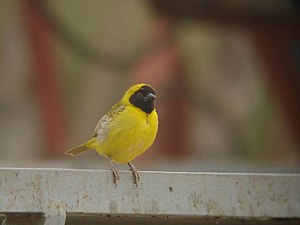Dwarf weaver
| Dwarf weaver | ||||||||||||
|---|---|---|---|---|---|---|---|---|---|---|---|---|

Dwarf weaver ( Ploceus luteolus ) |
||||||||||||
| Systematics | ||||||||||||
|
||||||||||||
| Scientific name | ||||||||||||
| Ploceus luteolus | ||||||||||||
| ( Lichtenstein , 1823) |
The dwarf weaver ( Ploceus luteolus ) is a species from the family of weaver birds (Ploceidae). The species comes from Africa and is occasionally kept as an ornamental bird in Europe .
description
The dwarf weaver reaches a body length of twelve centimeters, although it is by no means the smallest species of weaver bird despite its German name. In the magnificent dress, the male is yellow with a black beak and a black face mask. The top of the body is green, with the individual feathers having yellow hems. When resting, the males resemble the females. The female wears brown to black plumage all year round. The individual feathers are lined with light yellow. The underside of the body is light yellow to whitish.
distribution and habitat
The distribution area of the dwarf weaver covers a wide strip of land south of the Sahara , which stretches from West Africa to East Africa . It stretches from southern Mauritania , Senegal and Gambia in West Africa via Guinea , Mali , the Ivory Coast , Burkina Faso , Benin , Niger and Nigeria , Chad , northern Cameroon , the Central African Republic to southern Sudan and South Sudan , and Ethiopia Eritrea and in a southerly direction via Kenya to the Serengeti in northern Tanzania . The habitat are light dry forests and savannas . The species has also opened up human habitat and is also found in towns and gardens.
Way of life
Dwarf weavers breed in bushes and acacias . The clutch is incubated for twelve days. The male plays only a minor role in the breeding business. The male is more involved in the rearing of the young birds. The nestling period is three weeks. The young wings are looked after by the parent birds for a further two weeks after they have fled.
Taxonomy
The dwarf weaver was described in 1823 by Martin Hinrich Lichtenstein in a directory of duplicates of the Zoological Museum of the Royal University of Berlin as Fringilla luteola based on a type specimen from Senegambia .
The dwarf weaver population living at the foot of Mount Elgon in Uganda has been described as the subspecies Ploceus luteolus kavirondensis (Someren, 1921). However, this subspecies cannot be clearly distinguished from the other representatives of the dwarf weaver and is therefore not recognized by all authors.
literature
- Horst Bielfeld : Knowing and caring for 300 ornamental birds. Ulmer Verlag, Stuttgart 2009, ISBN 978-3-8001-5737-2 .
- Hinrich Lichtenstein: Directory of doubles in the Zoological Museum of the Königl. University of Berlin: together with a description of many previously unknown species of mammals, birds, amphibians and fish. Berlin 1823, p. 23. (first description)
Individual evidence
- ↑ Ploceus luteolus distribution map at IUCN . Retrieved December 1, 2013.
- ↑ a b Videos, photos and sound recordings for Little Weaver (Ploceus luteolus) in the Internet Bird Collection. Accessed November 4, 2013.
- ↑ Ploceus luteolus at Avibase - the world bird database. Retrieved November 4, 2013.
Web links
- Ploceus luteolus inthe IUCN 2013 Red List of Threatened Species . Listed by: BirdLife International, 2012. Retrieved September 1, 2013.
- Videos, photos, and sound recordings for Little Weaver (Ploceus luteolus) in the Internet Bird Collection